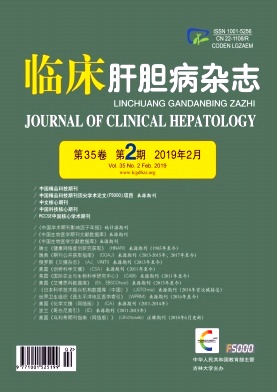|
[1]Chinese Society of Hepatology, Chinese Medical Association;Chinese Society of Gastroenterology, Chinese Medical Association;Chinese Society of Infectious Diseases, Chinese Medical Association.Consensus on the diagnosis and treatment of cholestasis liver diseases (2015) [J].J Clin Hepatol, 2015, 31 (12) :1989-1999. (in Chinese) 中华医学会肝病学分会, 中华医学会消化病学分会, 中华医学会感染病学分会.胆汁淤积性肝病诊断和治疗共识 (2015) [J].临床肝胆病杂志, 2015, 31 (12) :1989-1999.
|
|
[2]CAREY EJ, ALI AH, LINDOR KD.Primary biliary cirrhosis[J].Lancet, 2015, 386 (10003) :1565-1575.
|
|
[3]HIRSCHFIELD GM, KARLSEN TH, LINDOR KD, et al.Primary sclerosing cholangitis[J].Lancet, 2013, 382 (9904) :1587-1599.
|
|
[4]HORSLEY-SILVA JL, CAREY EJ, LINDOR KD.Advances in primary sclerosing cholangitis[J].Lancet Gastroenterol Hepatol, 2016, 1 (1) :68-77.
|
|
[5]LI Y, TANG R, LEUNG PSC, et al.Bile acids and intestinal microbiota in autoimmune cholestatic liver diseases[J].Autoimmun Rev, 2017, 6 (9) :885-896.
|
|
[6]LIU HX, KEANE R, SHENG L, et al.Implications of microbiota and bile acid in liver injury and regeneration[J].J Hepatol, 2015, 63 (6) :1502-1510.
|
|
[7]SCHNEIDER KM, ALBERS S, TRAUTWEIN C.Role of bile acids in the gut-liver axis[J].J Hepatol, 2018, 68 (5) :1083-1085.
|
|
[8]BEGLEY M, GAHAN CG, HILL C.The interaction between bacteria and bile[J].FEMS Microbiol Rev, 2005, 29 (4) :625-651.
|
|
[9]SPIVEY JR, BRONK SF, GORES GJ.Glycochenodeoxycholateinduced lethal hepatocellular injury in rat hepatocytes.Role of ATP depletion and cytosolic free calcium[J].J Clin Invest, 1993, 92 (1) :17-24.
|
|
[10]ALLEN K, JAESCHKE H, COPPLE BL.Bile acids induce inflammatory genes in hepatocytes:A novel mechanism of inflammation during obstructive cholestasis[J].Am J Pathol, 2011, 178 (1) :175-186.
|
|
[11]CAI SY, OUYANG X, CHEN Y, et al.Bile acids initiate cholestatic liver injury by triggering a hepatocyte-specific inflammatory response[J].JCI Insight, 2017, 2 (5) :e90780.
|
|
[12]O'BRIEN KM, ALLEN KM, ROCKWELL CE, et al.IL-17Asynergistically enhances bile acid-induced inflammation during obstructive cholestasis[J].Am J Pathol, 2013, 183 (5) :1498-1507.
|
|
[13] SLIJEPCEVIC D, van de GRAAF SF.Bile acid uptake transporters as targets for therapy[J].Dig Dis, 2017, 35 (3) :251-258.
|
|
[14]HOFMANN AF, HAGEY LR.Bile acids:Chemistry, pathochemistry, biology, pathobiology, and therapeutics[J].Cell Mol Life Sci, 2008, 65 (16) :2461-2483.
|
|
[15]STIEGER B, BEUERS U.The canalicular bile salt export pump BSEP (ABCB11) as a potential therapeutic target[J].Curr Drug Targets, 2011, 12 (5) :661-670.
|
|
[16]LI T, APTE U.Bile acid metabolism and signaling in cholestasis, inflammation, and cancer[J].Adv Pharmacol, 2015, 74:263-302.
|
|
[17]TRAUNER M, HALILBASIC E.Nuclear receptors as new perspective for the management of liver diseases[J].Gastroenterology, 2011, 140 (4) :1120-1125.
|
|
[18]KEITEL V, REICH M, HUSSINGER D.TGR5:Pathogenetic role and/or therapeutic target in fibrosing cholangitis[J].Clin Rev Allergy Immunol, 2015, 48 (2-3) :218-225.
|
|
[19]KEITEL V, HUSSINGER D.TGR5 in cholangiocytes[J].Curr Opin Gastroenterol, 2013, 29 (3) :299-304.
|
|
[20]CHIANG JY.Bile acid metabolism and signaling[J].Compr Physiol, 2013, 3 (3) :1191-1212.
|
|
[21]CZUL F, LEVY C.Novel therapies on primary biliary cirrhosis[J].Clin Liver Dis, 2016, 20 (1) :113-130.
|
|
[22]TRAUNER M, FUCHS CD, HALILBASIC E, et al.New therapeutic concepts in bile acid transport and signaling for management of cholestasis[J].Hepatology, 2017, 65 (4) :1393-1404.
|
|
[23]TILG H, CANI PD, MAYER EA.Gut microbiome and liver diseases[J].Gut, 2016, 65 (12) :2035-2044.
|
|
[24]TANG R, WEI Y, LI Y, et al.Gut microbial profile is altered in primary biliary cholangitis and partially restored after UDCAtherapy[J].Gut, 2018, 67 (3) :534-541.
|
|
[25]CHUNG BK, GUEVEL BT, REYNOLDS GM, et al.Phenotyping and auto-antibody production by liver-infiltrating Bcells in primary sclerosing cholangitis and primary biliary cholangitis[J].J Autoimmun, 2017, 77:45-54.
|
|
[26]MATTNER J.Impact of microbes on the pathogenesis of primary biliary cirrhosis (PBC) and primary sclerosing cholangitis (PSC) [J].Int J Mol Sci, 2016, 17 (11) :1864.
|
|
[27]TABIBIAN JH, TALWALKAR JA, LINDOR KD.Role of the microbiota and antibiotics in primary sclerosing cholangitis[J].Biomed Res Int, 2013, 2013:389537.
|
|
[28]HALILBASIC E, FUCHS C, HOFER H, et al.Therapy of primary sclerosing cholangitis-today and tomorrow[J].Dig Dis, 2015, 33 (Suppl 2) :149-163.
|
|
[29]WOODHOUSE CA, PATEL VC, SINGANAYAGAM A, et al.Review article:The gut microbiome as a therapeutic target in the pathogenesis and treatment of chronic liver disease[J].Aliment Pharmacol Ther, 2018, 47 (2) :192-202.
|
|
[30]WATANABE M, FUKIYA S, YOKOTA A.Comprehensive evaluation of the bactericidal activities of free bile acids in the large intestine of humans and rodents[J].J Lipid Res, 2017, 58 (6) :1143-1152.
|
|
[31]JUST S, MONDOT S, ECKER J, et al.The gut microbiota drives the impact of bile acids and fat source in diet on mouse metabolism[J].Microbiome, 2018, 6 (1) :134.
|
|
[32]INAGAKI T, MOSCHETTA A, LEE YK, et al.Regulation of antibacterial defense in the small intestine by the nuclear bile acid receptor[J].Proc Natl Acad Sci U S A, 2006, 103 (10) :3920-3925.
|
|
[33]SAYIN SI, WAHLSTRM A, FELIN J, et al.Gut microbiota regulates bile acid metabolism by reducing the levels of tauro-beta-muricholic acid, a naturally occurring FXR antagonist[J].Cell Metab, 2013, 17 (2) :225-235.
|
|
[34]KIM I, AHN SH, INAGAKI T, et al.Differential regulation of bile acid homeostasis by the farnesoid X receptor in liver and intestine[J].J Lipid Res, 2007, 48 (12) :2664-2672.
|
|
[35]OUT C, PATANKAR JV, DOKTOROVA M, et al.Gut microbiota inhibit Asbt-dependent intestinal bile acid reabsorption via Gata4[J].J Hepatol, 2015, 63 (3) :697-704.
|







 DownLoad:
DownLoad: